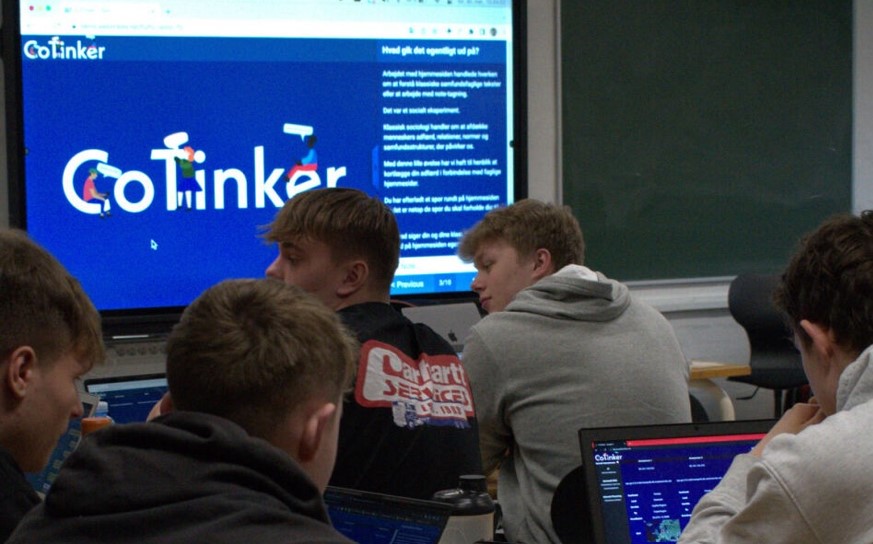Researchers have a surprise for school students: The internet knows who you are
Every time you click your way through the web, you leave a trace. But you might be surprised by just HOW well the internet knows you. This was certainly the case for a group of upper-secondary school students who took part in a course on data security developed by AU researchers. We can all learn something from the project, which will now be developed further.

A quick click on a link. A momentary glace at an advertisement. The speed of your mouse. These are all pieces of the jigsaw puzzle that the internet is making of you.
Cybersecurity
In connection with this year’s MatchPoints conference on cybersecurity on 18-19 April, AU is shining a spotlight on cybersecurity. You may also be interested in:
CoTinker
CoTinker is a new learning platform and modular teaching toolkit that helps upper-secondary school students learn about data security. It was developed by researchers at the Department of Computer Science and computer science teachers from Aalborg Katedralskole and Favrskov Gymnasium in collaboration with the Center for Computational Thinking and Design, Videnscenter for Digital Teknologiforståelse (the Danish knowledge centre for digital technological literacy), and the Centre for Advanced Visualization and Interaction – with funding from IT University West. The next phase of development will be financed by the Novo Nordisk Foundation. Researchers presented the technology behind CoTinker and the results of the project at the SIGCSE Computer Science Education conference in the USA in March.
One school day in April 2023, a group of computer science students at Favrskov Gymnasium and Aalborg Katedralskole were asked to evaluate a website. They’d done this before. But after exploring the website, the students were in for a surprise. The task was not about evaluating after all. It was about the trace that the students left behind – simply by clicking around the website.
The researchers running the course presented the user data to the students in an anonymised form, and to the students’ surprise, they could easily guess who was hiding behind the data – for example, who had clicked on which adverts, and who had spent a long time on particular parts of the website.
“I left so many traces that it was easy to identify me” and “the website is taking revenge” were some of the comments from the students after the exercise.
We need a better understanding of data
The course was developed by computer science postdoc Line Have Musaeus and her colleagues in collaboration with computer science teachers. The website that students were asked to evaluate was created especially for the course and contained information about what students could do in a gap year after upper-secondary school.
“Our research shows that secondary school students are more motivated to understand data issues if they work with their own data. In principle, the data we collected on them could have been collected by any commercial enterprise. But if you’ve looked up a sports folk high school online, are you really interested in being bombarded with adverts for Adidas trainers on other platforms like Instagram? The way we behave in one place is being used everywhere else,” says Line Have Musaeus.
We leave a trail of data behind us, but it’s hard for individuals to do anything about it. Some people occasionally click on something they’re not interested in or on an advert for a political party they don’t agree with – just to obscure their profile and create a more nuanced feed for themselves. This helps to fight against both commercial and political echo chambers. According to Line Have Musaeus, we could all benefit from being more aware of the mechanisms we’re subject to, but the responsibility ultimately lies at a higher level:
“If there is a political will to control what large tech firms may and may not do, we need to have an informed discussion about what data is. Otherwise the discussion becomes very abstract. We don’t yet have a full grasp of what data firms can actually collect, and this is something our project can help with,” says Line Have Musaeus.
Just as visible in the virtual world as in the real world
This time around, the computer science course was developed as a prototype. Approximately 60 students took part. Now AU researchers are looking for Danish teachers to help develop the course further so that it can form part of Danish and other subjects. Digital literacy is part of the Danish school curriculum across all subjects.
Associate Professor Jens Horskjær Hvelplund from Favrskov Gymnasium has used CoTinker in his computer science and social studies classes:
“In my computer science lessons, I used the CoTinker tool to visualise the data collection that takes place when students surf the web. The students found it interesting, because the tool was designed as an experiment, and there was also a competitive element, which encouraged them to participate actively. In my social science classes, I used the tool as part of a module on physical and digital data, and students realised that they’re just as visible on the internet as they are when they walk down the street,” says Jens Horskjær Hvelplund.
He has a lot of experience using CoTinker as part of his teaching:
“CoTinker is designed so that children are actively encouraged to discuss issues as they arise, and the technology ensures that they also have to follow each other during the activity. Both of these things really help the students to remember their experience with CoTinker in subsequent teaching modules. In this way, it can be a reference point for an entire teaching programme.”

